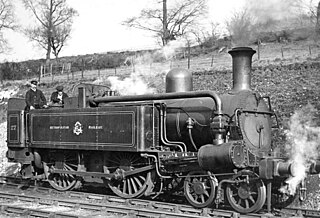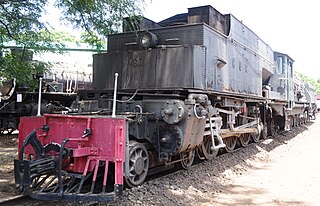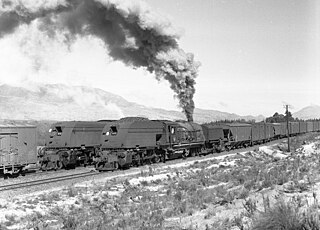
A Garratt locomotive is a type of steam locomotive invented by British engineer Herbert William Garratt that is articulated into three parts. Its boiler, firebox, and cab are mounted on a centre frame or "bridge". The two other parts, one at each end, have a pivot to support the central frame; they consist of a steam engine unit – with driving wheels, trailing wheels, valve gear, and cylinders, and above it, fuel and/or water storage.

Beyer, Peacock and Company was an English railway locomotive manufacturer with a factory in Openshaw, Manchester. Founded by Charles Beyer, Richard Peacock and Henry Robertson, it traded from 1854 until 1966. The company exported locomotives, and machine tools to service them, throughout the world.

The Metropolitan Railway A Class and B Class were 4-4-0T condensing steam locomotives built for the Metropolitan Railway by Beyer Peacock, first used in 1864. A total of 40 A Class and 26 of the slightly different B Class were delivered by 1885. Used underground, the locomotives condensed their steam, and coke or smokeless coal was burnt to reduce the smoke.

Under the Whyte notation for the classification of steam locomotives by wheel arrangement, a 4-6-2+2-6-4 is a Garratt or Union Garratt articulated locomotive using a pair of 4-6-2 engine units back to back, with the boiler and cab suspended between them. The 4-6-2 wheel arrangement of each engine unit has four leading wheels on two axles, usually in a leading bogie, six powered and coupled driving wheels on three axles, and two trailing wheels on one axle, usually in a trailing truck.

Under the Whyte notation for the classification of steam locomotives by wheel arrangement, the 0-4-0+0-4-0 is an articulated locomotive of the Garratt type. The wheel arrangement is effectively two 0-4-0 locomotives operating back-to-back or face-to-face, with the boiler and cab suspended between the two power units. Each power unit has no leading wheels, four powered and coupled driving wheels on two axles and no trailing wheels. A similar arrangement exists for Mallet, Meyer and Fairlie locomotives, but is referred to as 0-4-4-0.

The NZR G class was a type of Garratt locomotives used in New Zealand, later rebuilt as Pacific type locomotives. They were the only Garratt type steam locomotives ever used by the New Zealand Railways (NZR). They were ordered to deal with traffic growth over the heavy gradients of the North Island Main Trunk (NIMT) and to do away with the use of banking engines on steep grades. They were one of the few Garratt designs to employ six cylinders. A mechanical stoker was used to feed coal into the locomotive. The locomotives lasted longer in rebuilt form as standard Pacific locomotives than they did as Garratts, but their numerous mechanical issues lead to their final withdrawal following a union ban on their use in 1956.

Under the Whyte notation for the classification of steam locomotives by wheel arrangement, the 4-8-4+4-8-4 is a Garratt locomotive. The wheel arrangement is effectively two 4-8-4 locomotives operating back to back, with the boiler and cab suspended between the two engine units. Each engine unit has two pairs of leading wheels in a leading bogie, followed by four coupled pairs of driving wheels and two pairs of trailing wheels in a trailing bogie.

The South African Railways Class GL 4-8-2+2-8-4 of 1929 was an articulated steam locomotive.
Under the Whyte notation for the classification of steam locomotives by wheel arrangement, a 4-8-2+2-8-4 is a Garratt articulated locomotive consisting of a pair of 4-8-2 engine units back to back, with the boiler and cab suspended between them. The 4-8-2 wheel arrangement has four leading wheels on two axles, usually in a leading bogie, eight powered and coupled driving wheels on four axles and two trailing wheels on one axle, usually in a trailing truck. Since the 4-8-2 type is generally known as a Mountain, the corresponding Garratt type is usually known as a Double Mountain.

Under the Whyte notation for the classification of steam locomotives by wheel arrangement, 2-6-2+2-6-2 is an articulated locomotive using a pair of 2-6-2 power units back to back, with the boiler and cab suspended between them. The 2-6-2 wheel arrangement has a single pair of leading wheels in a leading truck, followed by three coupled pairs of driving wheels and a pair of trailing wheels in a trailing truck.

Under the Whyte notation for the classification of steam locomotives by wheel arrangement, a 2-8-2+2-8-2 is an articulated locomotive using a pair of 2-8-2 power units back to back, with the boiler and cab suspended between them. The 2-8-2 wheel arrangement has a single pair of leading wheels in a leading truck, followed by four coupled pairs of driving wheels and a pair of trailing wheels in a trailing truck. Since the 2-8-2 type was known as Mikado, the corresponding Garratt and Modified Fairlie types were usually known as Double Mikado.

The New South Wales Z25 class was a class of 2-6-0 steam locomotives operated by the New South Wales Government Railways of Australia.

The South African Railways Class 15F 4-8-2 of 1938 is a steam locomotive.

The South African Railways Class NG G16 2-6-2+2-6-2 is a narrow gauge steam locomotive class.

The South African Railways Class NG G11 2-6-0+0-6-2 of 1919 is a class of narrow gauge steam locomotives.

The South African Railways Class GH 4-6-2+2-6-4 of 1928 was an articulated steam locomotive.
The South African Railways Class GA 2-6-0+0-6-2 of 1921 was an articulated steam locomotive.

The South African Railways Class GB 2-6-2+2-6-2 of 1921 was an articulated steam locomotive.

The South African Railways Class GEA 4-8-2+2-8-4 of 1946 was an articulated steam locomotive.

The South African Railways Class GM 4-8-2+2-8-4 of 1938 was an articulated steam locomotive.


















